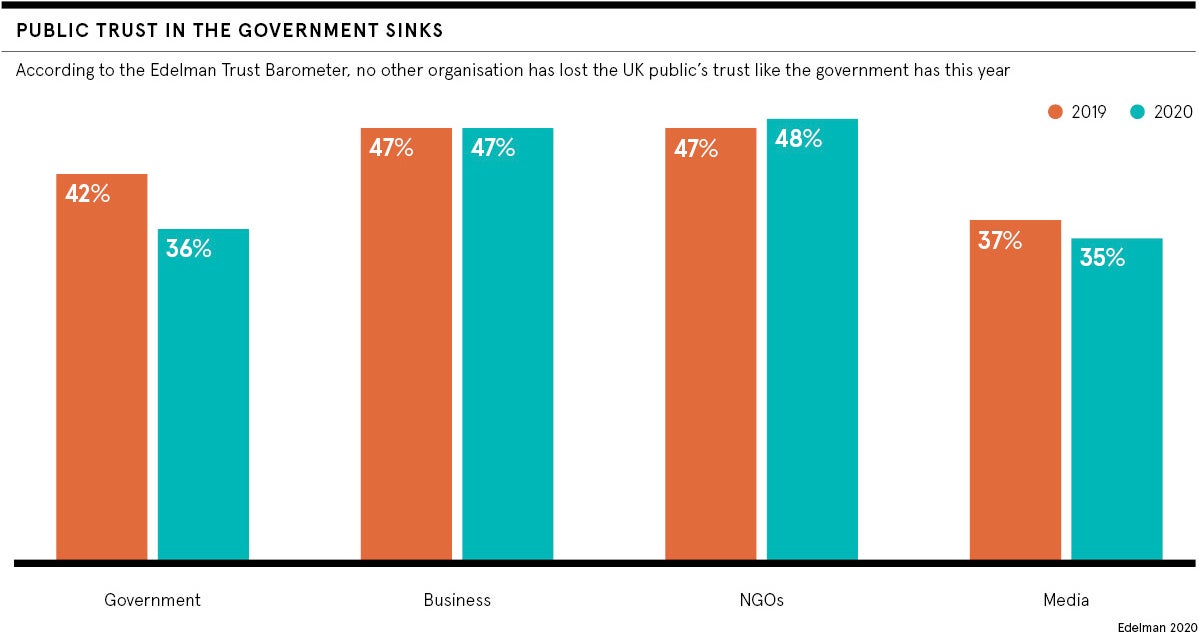
Public sector procurement is an ongoing and major challenge for nation states everywhere, accounting for one third of government expenditure, according to the Organisation for Economic Co-operation and Development. Coronavirus exposed governments that favour narrow procurement processes over timely outcomes or don’t follow due process at all.
It’s no coincidence that a leader in government procurement, South Korea, has one of the lowest death rates from COVID-19; open, shared and contextual data means it can procure and distribute personal protective equipment (PPE) and tests effectively and fairly.
As the world emerges from the first phase of the pandemic, the chorus for a socially just and sustainable recovery grows louder and trusted procurement must play a central role. The Institute for Public Policy Research (IPPR) recommends central government, local authorities, and metro mayors build consideration of the use of data for local public good into procurement guidelines.
“Competition policy alone is not the answer; ways to pool, share and use data must be developed so it can be used for public benefit rather than private profit,” says Rachel Statham, senior research fellow at IPPR Scotland.
To achieve trust you have to publish data in a way that’s clear and usable by everyone
Trust in governments is falling, according to the Edelman Trust Barometer, which most recently ranked the UK in 27th place, just above Russia. National Audit Office (NAO) findings that UK government contracts awarded during the COVID-19 pandemic were opaque, undocumented and partial is likely to dent citizen trust further, the NAO warns. “While we recognise these were exceptional circumstances, it remains essential decisions are properly documented and made transparent if government is to maintain public trust that taxpayers’ money is being spent appropriately and fairly,” it says.
In particular, the NAO highlights difficulties that accrued when UK government agencies didn’t plan in advance and purchased PPE at the last minute. A myopic procurement perspective coupled with an annual spend of £350 billion spells trouble, says Neville Cannon, senior director analyst at Gartner. “What could have helped was transparency and open data. Rather than a narrow focus on procurement, a deep and contextual look at supply chain management would have flagged up shortages early on,” he notes.
Focus on contextual procurement lifecycle
Kevin Sample, senior consultant with healthcare supply chain management specialist GHX, says: “Healthcare providers had no view of what PPE they had or what they needed and no ability to forecast demand, meaning suppliers couldn’t scale up accurately.” Real-time knowledge isn’t only important during a pandemic, says Sample, it is best practice. “Rather than being reactive organisations, public agencies need a forecast model, then suppliers aren’t put in the position of choosing which orders to fulfil and clients to prioritise,” he adds.
COVID-19 provides an opportunity to reset public sector procurement and reconfigure an exercise that traditionally balances risk and value, says Cannon. The pandemic disrupted normal practices and continuity of services was prioritised over looking after the economy, a disruption that’s created a new context for procurement. “Local authorities bought cloud-based applications to enable staff to work from home and learnt the value of doing things in a totally different way,” he says. Consequently, many are reviewing their real estate to see what can be released to balance the books.
Ways to share data must be developed so it can be used for public benefit rather than private profit
Using data contextually and throughout procurement life cycles, including monitoring and measurement of service delivery, would help achieve the recommendations of Westminster think tank Reform. A primary criticism contained in its 2019 review of UK public sector procurement was: “Too many resources are invested in the contracting-out phase of the procurement cycle, at the expense of contract management, resulting in an imbalanced procurement cycle and a lack of effective monitoring for outsourced services.”
Assessing procurement needs in context, according to real-time data and current circumstances, is some way off. But the mandatory use of the Open Contracting Data Standard does assist transparency of procurement and some agencies share best practice.
The Government Digital Service (GDS) is a protagonist: G-Cloud set up framework agreements that let agencies buy cloud services without having to run full tender or competition procurement process. Best practice has since expanded into the government’s Digital Marketplace and October’s Digital Buying Guide, which uses international exemplars to show how to procure IT in an open, fair and effective way.

Extend competitive dialogue to diverse demographics
“Procurement reform at the GDS is aimed at sustainability, fairness and opening up markets,” explains Natalie Taylor, managing director, public sector, at Foundry4 consultancy. Spreading government spending and extending competitive dialogue across different businesses and demographics stimulates the economy and promotes fairness.
“As well as openly publishing all contracts and tender opportunities on a digital platform, it’s important to open up framework agreements to smaller and diverse players,” says Taylor.
While all contracts awarded and tendered on the Digital Marketplace are public domain and adhere to open data and contracting standards, they lag behind the South Korean government procurement model in one important respect: there’s no digital dashboard for citizens to check supplier performance and value delivered after the procurement event. Such details cannot be accessed without resorting to a Freedom of Information request.
The lack of technical expertise in making and managing procurement decisions is another continuing concern. Despite efforts to upgrade commercial skills in the Government Commercial Function network and Crown Commercial Service, Reform notes: “The Public Accounts Committee has a long-standing concern about the ability of the civil service to not only draw up contracts, but also to manage them.” The net result is public sector procurement across central and local government remains fragmented and opaque.
“It can be complicated to do business with government”, suggests Simon Payne, client director at procurement specialist, Proxima. “It’s a complex landscape to navigate with a high cost to entry for some. If you want to tender for central government contracts, you have to be registered on multiple systems. Contracts tendered on OJEU (Official Journal of the European Union) are designed to ensure an open, transparent and fair tender process”. This is critically important but the complexity can mean that decisions take months or even years.
Disruption brings opportunity to recast tender process
Payne believes a post-Brexit world provides the opportunity to rewrite tender procedures and produce more equitable and trusted outcomes. At present, OJEU rules prevent the use of social value as an evaluation criteria unless it’s directly related to the goods or service procured. “In future, social value could be hardcoded in supplier evaluations, whether being carbon neutral or paying the living wage, and suppliers’ track records evaluated through open data,” he says.
Using digital technologies, such as blockchain, a distributed, immutable ledger, offers a further opportunity to embed trust within procurement life cycles as an unalterable record of supplier history and buyer procedure creates a trusted context for all parties.
The Food Standards Agency piloted blockchain for regulating procurement chains and discovered additional benefits of sharing data across ecosystems. Sharing trusted data could help suppliers monitor inventory usage and forecast demand better, a key procurement weakness exposed during the pandemic.
The disruptions of Brexit and COVID bring opportunities to recast public sector procurement with a fresh focus on data and context. But reframing procurement language is important too. As Foundry4’s Taylor concludes: “There is a gap between transparency and gaining trust; to achieve trust you have to publish data in a way that’s clear and usable by everyone.”
Reform procurement through connected, clean data

Comprehensive, up-to-date, and publicly accessible data is vital, not only to manage government procurement better - but also to reform it, argues Spend Network. The government data analyst specialists are on a mission to capture data from every government contract in the world and openly publish it.
At present, public sector procurement contract data is patchy, inconsistent and sometimes incorrect: only 4.5 per cent of tenders are published with an estimated budget; over 86 per cent of contracts don’t feature an end date; and supplier data is hard to identify and aggregate, often recorded as acronyms, or brand and project names, according to Spend.
Good data would put government agencies on the front foot, letting them identify the best sub-contractors for a contract, predict tenders that only attract single bids, and spot fraud and collusion. Instead of focussing on over-protective measures that stifle innovation or underestimate the impact of failure, data should be used to shed light on the actual risks associated with contracting, argues the data specialist.
NHS Scotland is saving money and increasing patient safety through data-driven procurement and inventory management and by linking the consumption of products to individual patients. An inventory management system enables items to be bought in bulk and stored centrally and lets each healthcare provider run a Top-Up Service, ordering stock by scanning barcodes from a smartphone.
“The system allows real-time recording of procedures and increased transparency of what is being used”, explains Elizabeth McSorley, modality lead, Interventional Radiology at NHS Greater Glasgow and Clyde. “Reports, generated at the click of a button, can be tailored to the examination, consultant or item used. We have confidence in maintaining accurate patient records as items are scanned at the point of use,” she says.
The software from healthcare software specialist, GHX, combined with global data standards (GS1) and input from clinicians in acute environments, is also set to improve NHS Scotland’s capability to manage COVID-19 consumables. Making procurement automated, intuitive and joined-up provides data about consumption and makes the entire supply chain visible, in turn supporting improvements to patient care and staff safety.

Public sector procurement is an ongoing and major challenge for nation states everywhere, accounting for one third of government expenditure, according to the Organisation for Economic Co-operation and Development. Coronavirus exposed governments that favour narrow procurement processes over timely outcomes or don’t follow due process at all.
It’s no coincidence that a leader in government procurement, South Korea, has one of the lowest death rates from COVID-19; open, shared and contextual data means it can procure and distribute personal protective equipment (PPE) and tests effectively and fairly.
